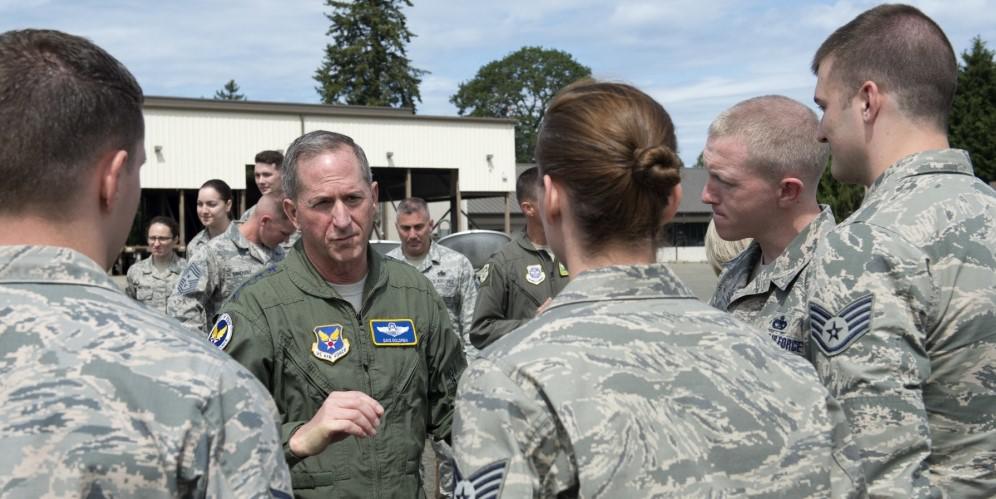Air Force Looks Past the Initial Onset of COVID-19
The U.S. Air Force has initially adjusted to the onset of the COVID-19 pandemic and is now shifting to operate under a new paradigm for the foreseeable future, Chief of Staff of the U.S. Air Force Gen. David Goldfein, USAF, stated. The service has examined how to sustain its critical Defense Department mission areas despite the prominence of the virus. The Air Force has adjusted its methods to ensure operation of its nuclear defense; space; intelligence, surveillance and reconnaissance; air mobility and cyber missions, the core functions needed to defend the nation. “We still have a hot fight going on,” Gen. Goldfein stated. “So, intelligence, surveillance, reconnaissance and air mobility are critical.”
The chief of staff of the Air Force spoke to reporters on April 22 during a virtual Defense Writers Group event. “We went through a process several weeks ago that I called the reset to the new normal,” the chief explained. “And the new normal as I defined it was how do we still operate with breadth and depth across the key mission areas."
With that first reset, the service put in place procedures to operate while protecting airmen and their families. “And knock on wood, they are working so far,” he shared. “We have zero positive COVID cases in the nuclear area. We have zero positive cases in air mobility … amongst the crews. We're continuing to apply missions … and we are seeing no degradation."
For example, Gen. Maryanne Miller, USAF, commander at the Air Mobility Command headquartered at Scott Air Force Base, Illinois, put in place protocols and procedures to sustain sorties, such as isolating the crew in a clean environment and making sure that the cockpit itself is clean. “We haven't stopped flying around the world,” the chief observed. “Even though Italy is recovering from a pretty significant [infection rate], we're still flying missions at Aviano in Northern Italy.”
The chief is now preparing to implement what he refers to as the service’s second reset in response to the pandemic, one that will mean operating in a “new abnormal” environment. Gen. Goldfein sees the service moving more and more to an ability to survive and operate, or ATSO, mentality, at least over the next year.
“What we're looking at now, though, is a 1 June reset to what I call not the new normal, but the new abnormal,” he explained. “I'm defining it as living and operating with a cyclical virus until we get a vaccine. And all the projections are no vaccine for upwards of a year. So that means we've got to refine our ability to survive and operate and do the missions the nation requires.”
In the meantime, Gen. Goldfein is keeping a close eye on major aircraft programs in development, such as the F-35, KC-46, B-21 and the T-38, to watch out for any supply chain issues due to the pandemic. The service is addressing some concerns through the authorities granted in the Defense Production Act, which allows DOD to rapidly put companies on contract, the general noted. “As we continue to look at programs, we are not seeing any that are reaching a critical stage, i.e., where you just can't get the part we need,” Gen. Goldfein stated. “What we're really seeing is a slowing down of the normal timelines.”
With the F-35 as a starting point, Gen. Goldfein also has been speaking with his fellow international air chief cohorts, including from Canada and Italy, as well as the industry. “We’ve talked as Joint Chiefs and International Air Chiefs on how we keep the industrial base alive through the COVID-19 crisis so that we emerge in the back end being able to continue to produce the capabilities that we know we need,” he stated. “It's not just about the prime contractors, it's actually about the subs, the tier-two and tier-three suppliers, to make sure that we keep that industry base alive. And perhaps by collaborating, we can all contribute in a way that keeps things on track.”
The service is still leading the military’s pursuit of Joint All-Domain Command and Control, or JADC2, to enable multidomain operations (MDO) for integrated warfighting across the air, space, sea, land and cyber domains. The service is working directly in support of the U.S. Northern Command to develop advanced battle management tools to enable JADC2, and they have found that the pandemic has actually offered opportunities to harness and test out real-time tools, the general said.
The chief acknowledged the Government Accountability Office’s (GAO’s) recent report on the service’s planned Advanced Battle Management System (ABMS), which will enable MDO. The GAO asserted, among other things, that the “Air Force hasn’t developed a complete plan for the system.” Gen. Goldfein pointed out, however, that the GAO did not have clearance to classified levels of information about the ABMS and saw an incomplete picture.
“So, now what we need to do is use this as an opportunity to educate,” the chief explained. “And my commitment to the GAO … is that we're going to walk through it all because we need the GAO to be fully knowledgeable of everything we're doing. And this is also going to be an opportunity for the GAO and others to understand how to report when you have a service that's going as fast as we are. We're demonstrating something every four months. And even though the last big demo for April was postponed, we haven't slowed down. We have just shifted our radar, if you will.”




Comments